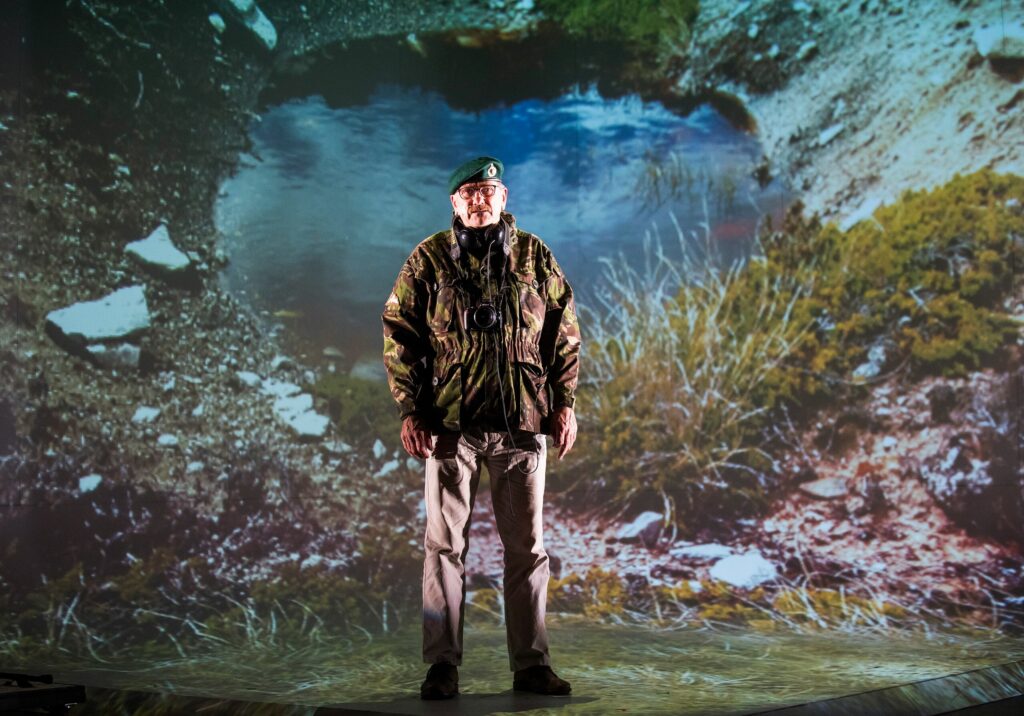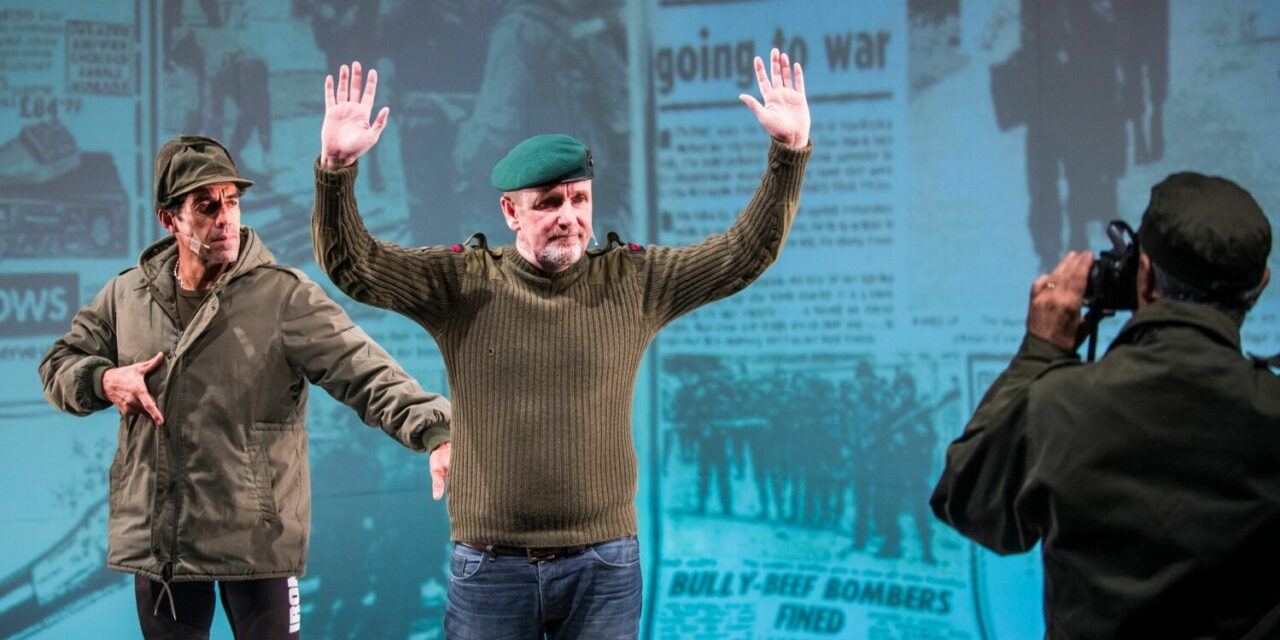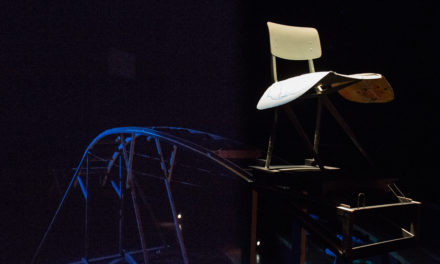Argentina And England Meet Again, More Or Less Peacefully, on the NYU Skirball Stage: North American Premiere Friday, January 11–Sunday, January 13, 2019
Jens Andermann, a professor in New York University’s Department of Spanish and Portuguese and an editor of the Journal of Latin American Cultural Studies, tells us in program notes for the “play” Minefield: “. . . on April 2 [1982] the head of the [Argentine] military Junta, General Galtieri, addressed a two-hundred-thousand strong, jubilant crowd celebrating the landing of Argentine troops that same morning on the Falkland Islands – or Islas Malvinas – the windswept, British-occupied Southern Atlantic archipelago mostly populated by sheep and seabirds. Following two and a half months of relentless propaganda about the Argentine army’s heroic victories, audiences in Buenos Aires suddenly woke up to the reality of humiliating defeat on [sic] the hands of the Royal Navy. 649 Argentine soldiers had lost their lives – many of them eighteen-year-old conscripts deployed to the islands as cannon fodder, victims of hunger, hypothermia, and tortures inflicted by their own officers as much as of British bombs and gunfire. 255 British soldiers, as well as three islanders, also died during the fighting. The following year, the Argentine dictatorship was ousted…”

Mara Isaacs
Innumerable accounts exist of flailing dictators, flailing military regimes, flailing economies, and even flailing democracies searching for distractions from their failing policies. Rarely do the cannon fodder – Syrian and Sudanese refugees washing up on Greek or Italian shores, Central American asylum-seekers arriving ignominiously in Tijuana, young female Boko Haram kidnapping and rape victims in Nigeria – get to tell their stories. Far less likely is that they will tell their stories on stages throughout the world, supported by the global theatre production network such as the one that supports Lola Arias’s work.
Arias’s role in Minefield is not described. We are not given a program booklet, only a brochure listing all the events of the 2018–19 NYU Skirball season. Her website identifies her this way:
“She is a writer, theatre and film director and performer. She collaborates with people from different backgrounds (war veterans, former communists, Bulgarian children, etc.) in theatre, literature, music, film and art projects. Her productions play with the overlap zones between reality and fiction. Since 2007, she develops her work in the field of documentary theatre.”
Did Arias fulfill all those obligations with Minefield? Presumably. I haven’t heard the phrase “documentary theatre” before, which quite accurately squares with where she falls in the interstices between the live theatre world and the much more widely known, understood, and an accepted world of “documentary film.”
The foundation of Minefield is that in 2016, 34 years later, Arias and her international network of collaborators deal with the actuality of and the fallout from the Malvinas/Falklands War (this review does not take a position on which name to use; the play thoroughly addresses that issue). Little attention is paid to the buildup to the war.
The play, enacted by three British (one of these also Gurkha) and three Argentine war veterans, opens with a hunky Argentine veteran of the war – unidentified, inexcusably, in the season brochure – decked out in a tight stretch tank top, stretch black bicycle pants, and sneakers, occupying center stage. The justification for the distracting, ironic juxtaposition of a male Latin sex symbol signifying the vicious and cynical underpinnings of the war emerges as the “play” moves on. (The play, strangely, is titled in what appears to be 72 point font as LOLA ARIAS: MINEFIELD in the season brochure, yet nowhere are any of the performers identified. They were cannon fodder in the war; now they are theatre fodder used to support Lola Arias’s international fame.). He alone of the three Argentine, two British, and one Gurkha war veterans is a stud, is buff, is seen superficially to have not been damaged by the war. How does he appear to be perhaps 38 years old? Or maximum 45, when he must be minimum 54? So hot? So exuding self-confidence, sexuality, physicality, machismo, life force? When the play is presumably about the suffering he endured 34 years before. His story unfolds, as do the stories of his five fellow veterans, both individually and personally, in the context of being Argentine – or British or Gurkha in the case of his three former enemies – in the context of being a soldier, in the context of being an individual whose life choices were so limited that he “chose” service in a misrepresented, sham war invented as a desperate 11th-hour survival strategy for a fatally damaged, echando la culpa (blame throwing) military regime. Then the play continues in the context of his getting to know his past enemies in group therapy exercises which were the auditions for and workshopping of this production. We THINK the war between Argentina and England, and the war between these six men, is finalized in and through the production itself, but it’s not true. The “play” seems to end, but pursues – correctly, in my view – one ending, and anticlimactically and unnecessarily, in my view, another ending.
Some great theatrical bits are scattered throughout the piece. It is painful to hear the story of a group of Argentine soldiers who are sent to a remote farmhouse to scavenge supplies. On the way back, “borrowing” a rowboat and forging a river, several are blown up by a landmine that was set by an earlier Argentine reconnaissance group who failed to report to their fellow soldiers where they had laid the mines. This led to many avoidable deaths and dismemberments. The disturbing stories of how the Brits and the Argentines returned years later to the remote, hellish place which caused so much suffering are told with such painful wound reopening that it seems as if they made the trip yesterday. The most excruciating moment of the entire play is the moment we are told that more British and Argentine veterans died of suicide after the war than of war injuries. They went to war with nothing, thinking they might come back with something – a sense of accomplishment, a sense of having been a part of something greater than their teenage economic or professional insecurity. But they came back with less. What noble goals were attained? What fame or recognition was achieved? What societal, historic, or cultural icons were saved? None.
There are some less-than-great theatrical elements also scattered throughout the piece. (And Minefield overall IS a scattering of bits and pieces.) It’s kind of funny to see a man in an “I am sexless” dark grey jacket, skirt, and rubber Margaret Thatcher mask portraying the late “iron lady” pontificating robotically about the greatness of the British empire – and the war did re-concretize her control of Parliament. But when the knobby-kneed, sixty-something Brit takes off the wig and mask, and parades about nonsensically, it adds no new take on the ancient British traditions of transvestitism and the panto.
The unnecessary and anticlimactic ending has the six actors/veterans performing unimaginative, generic rock music maybe from the Liverpool era, and there is talk about an Argentina-based Beatles cover band making its debut in Liverpool. But not all of the six veterans were musicians before the war, or had musical dreams, so why at the end of the play are they all musicians, playing loud uninspired guitars-with-drum-set music on a 4/4 beat? Dry ice smoke fills the air, clouding the supertitles. But why? More powerful, yet relegated to a lesser position in the overall schema, is the verbal battle that rages between the Brits and the Argentines – with the Gurkha taking the ancient Confucian view that “nothing changes, everything remains the same” vis-à-vis colonialism, machismo, and territorialism. The Brits cite historical data: “The Falklands are the Falklands and are British for the following legal, geographical, and historical reasons.” The Argentines cite contrarian data: “The Malvinas are the Malvinas and are Argentine for the following legal, geographical, and historical reasons.” In short, this war was for nothing. And even this play was for nothing. It superficially reconciled former combatants who once went to war because they had few or no economic or professional opportunities. But they have not really changed. They have merely learned a little more about each other. But chauvinism, Arias seems to conclude, is a permanent state of mind and of being.
People will want to read about Minefield. Some may even want to read Minefield, to understand or to feel more deeply what thousands of damaged, reluctant patriots used as cannon fodder experienced prior to, during, and after the war. But no one will want to restage this work. It had its moment. Sadly, other socially conscious plays are continually being rolled out about other doomed-to-fail permawars in areas such as Afghanistan, the Rohingya region of Myanmar, Syria, Yemen, and the regions where Boko Haram rules Nigeria. Unlike other artistic creations which have counted on wealthy Hollywood and other backers to state their case (the film Full Metal Jacket, e.g.), these poor veterans are left almost on their own, to make a few appearances in world theatre festivals where, presumably, all audience members already agree that “war is not healthy for children and other living things.” These performers will fade into the ignominy in which most veterans of other failed war efforts reside.
The Argentine and British vets we get to know through Minefield appreciate, listen to, care about, get sick over, and throw out the discomforting question: What is a world like where there ARE no alternatives? I had a negotiator say to me once, “Here is your option.” I said “No! AN option does not exist! Only ‘options’ exist!” Yet not for these vets. Were they brave? Coerced? Lied to? Taken advantage of? “All of the above,” it seems.
The most tragic takeaway of this piece is that there were no winners. As John Milton wrote in 1667, “Who overcomes by force hath overcome but half his foe.” The bravery of this work is that Arias has created an environment in which after 34 years of ineffectual efforts to bury or forget the past, these vets come together to declare, in valiant efforts at the preservation of an intact self, “We were right, and you were wrong!” The war is not over, in their minds or still ravaged souls, which bravely allow them to function, persevere, and even create, such an unlovely, unenduring, yet important work. May it inspire other witnesses and other conveners such as Arias to come forward to share their stories.
This band of veterans still squabbles, still nitpicks, still rankles, still resents. But at least they got the chance, through the visionary Arias, to get to know the other, who is, in reality, us.

Mara Isaacs
Jan Michael Hanvik, M.A., Center for Latin American and Caribbean Studies, New York University, is the Executive Director of the Pan American Art Research Inc., New York (www.pamar.org); Founder and Principal of Crossing Bridges LLC, New York (www.crossingbridges.nyc); and Founder and Director of Puentes y Redes S.C., Mexico City.
This post was written by the author in their personal capacity.The opinions expressed in this article are the author’s own and do not reflect the view of The Theatre Times, their staff or collaborators.
This post was written by Jan Michael Hanvik.
The views expressed here belong to the author and do not necessarily reflect our views and opinions.


















